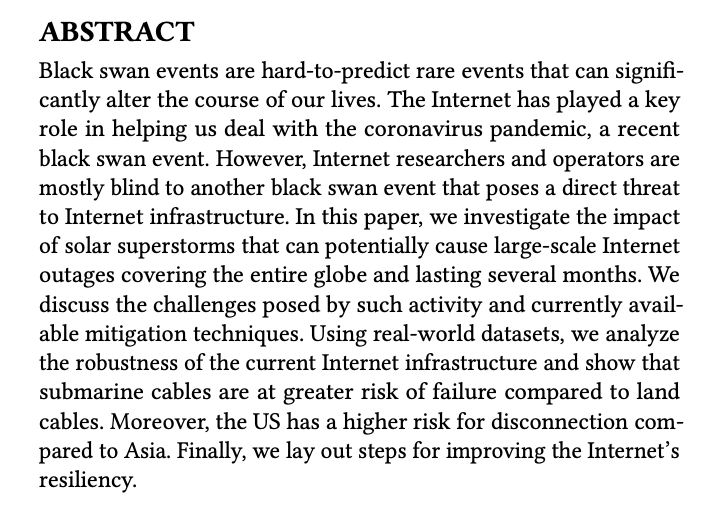Beware the Black swan!
The world could be plunged into an “internet apocalypse” because of a once in an approximately 100-year solar storm, a new study suggests.
Normally, the Earth’s magnetic field shields us from solar wind – charged particles streaming from the sun – by deflecting the electric winds towards the planet’s poles and creating scenic auroras, The Independent reports.
But, due to the Sun’s natural life cycle, once in about 80-100 years, solar winds morph into solar superstorms capable of causing catastrophic internet outages – or a ‘Black swan event’ – that could span the globe and last months. The concerns were presented at SIGCOMM 2021 – the annual conference of the ACM Special Interest Group on Data Communication.
The current solar cycle, the study says, has the potential to be one of the strongest on record.
Sangeetha Abdu Jyothi from the University of California, Irvine and VMware Research, assessed the resilience of the current Internet infrastructure in the paper and found long-distance optical fibre lines and submarine cables are vulnerable to the currents produced on the Earth’s crust by solar superstorms, also known as Coronal Mass Ejections (CME).
1/ A global Internet outage lasting weeks! Can that happen?
My paper "Solar Superstorms: Planning for an Internet Apocalypse" at #SIGCOMM'21 takes the first look at an important problem that the networking community had been overlooking until now: https://t.co/GROp6hf97c
— Sangeetha Abdu Jyothi (@sangeetha_a_j) July 29, 2021
“A Coronal Mass Ejection (CME) involves the emission of electrically charged matter and accompanying magnetic field into space. When it hits the earth, it interacts with the earth’s magnetic field and produces Geomagnetically Induced Currents (GIC) on the crust,” Jyothi explained in a tweet.
Currents from solar storms, the study noted, can damage long conductors such as power lines.
“In today’s long-haul Internet cables, the optical fiber is immune to GIC. But these cables also have electrically powered repeaters at ~100 km intervals that are susceptible to damages,” Jyothi added.
While the chances of the event happening varies from 1.6 per cent to 12 per cent per decade, Jyothi says the chances increase during the Sun’s maximum activity period in its waxing and waning cycle.
Luckily, Jyothi says, technological advances have coincided with a period of weak solar activity.
But, with the sun expected to become more active, she says the current Internet infrastructure has not been stress-tested by strong solar events.
“In short, we have NO IDEA how resilient the current Internet infrastructure is against the threat of CMEs!,” she noted in a tweet.
Jyothi said the last big solar storms happened in 1859 (Carrington event) and 1921 and noted that any superstorm would impact countries differently.
Internet infrastructure in higher latitudes, above the equator, face a higher risk, the report said. The US has a high risk of being disconnected from Europe, while Asia is more likely to retain connectivity.
9/ Consider the most vulnerable long-distance submarine cables for example. They are concentrated in higher latitudes, particularly between the US and Europe.
[Image: https://t.co/apN3mdrFlS] pic.twitter.com/nyHusQHNVB
— Sangeetha Abdu Jyothi (@sangeetha_a_j) July 29, 2021
Jyothi concluded that her paper was “just scratching the surface of an important problem” and noted a lot of work needed to be done to “understand the risk and robustify our infrastructure”.











































